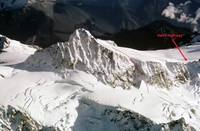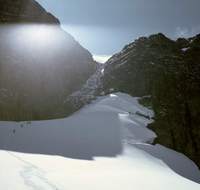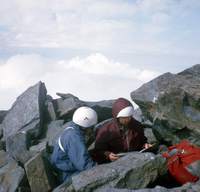Mount Shuksan:
the Hourglass
23 August 1969
Mount Shuksan
(9,131 feet)
may well be the most famous mountain in the US even though most people
do not know it by name.
It often serves as the
generic picture
for
“mountain.”
A
mural depicting Mount Shuksan
in New York's Grand Central Station has impressed commuters for many
years.
The mountain's beauty makes it a goal for aspiring mountaineers,
but even the easiest route requires knowledge of safe glacier travel and
steady nerves to tackle the exposed class 2-3 of the summit pyramid.

This aerial picture taken in Winter shows where the
“easy”
route takes a long detour around to
Hell's Highway
before traversing back to climb the
Summit Pyramid.
We
(Tom, Dave and I)
had taken the Hell's Highway route as part of the University of Washington's
Summer climbing seminar.
Upon reaching the Summit Pyramid,
we found it covered with
verglas
and too dangerous to climb.
After the seminar we decided to try again,
hoping a late August ascent would be less prone to icing.
Although this was our first year of climbing,
having just graduated the Beginning Climbing Course in May,
we decided to take the more technical but shorter Hourglass route
(thin red line).
For a picture of what the route might look like in Fall,
click here.

We made camp near Lake Ann and got an early morning start to the
mountain.
At the base of the Hourglass,
we had to negotiate the
randkluft
to transition from the glacier to the rock.
We then began belaying up the rock.
I took an early lead and wound up at a belay spot that was barely large
enough to get ½
of one boot on.
Fortunately,
the protection was very good and I could hang from it as I belayed Tom
and Dave up.
Switching leads was difficult in this cramped spot,
but they finally got by,
with one taking the lead and the other following once a new belay was
established.
This picture shows a party of four that were ahead of us as we approached
the Hourglass.
The rock is much steeper than it appears in the photo.

With both Tom and Dave well above me,
I suddenly heard:
“Rock! Gary! Rock!”
The team of four well above them had knocked off a rock.
There wasn't much I could do:
I was tied to the rock on a tiny ledge.
I leaned in as close to the rock as possible and tried to hunch my arms
and shoulders under my rock helmet as I braced for whatever might be
coming.
A rock smashed into my helmet and grazed my shoulder as it continued its
fall.
Without a rock helmet,
the blow would have been serious or fatal;
had it missed my helmet and hit my shoulder,
the bones would have been shattered.
We continued on and found the summit pyramid free of ice.
After scrambling up and down the pyramid,
we descended via Hell's Highway.
Back at camp I finally removed my
Bell TopTex
helmet
(actually a surfing helmet–climbing helmets were not developed yet).
The helmet liner stayed on my head–
it had been separated from the shell by the blow.
The shell had concentric circles of broken fiberglass centered where the
rock had hit,
and one could push the fiberglass in with a finger.
I bought a new helmet
(same brand)
when I got home.
Apparently Bell took these helmets off the market after they learned they
were being used for climbing.
This picture taken at the summit looking east shows
Mount Baker
in the background.
Tom and Dave are both wearing TopTex helmets like mine;
we added decorations so we could tell them apart and more easily
identify each other.
These helmets are now collector's items.


